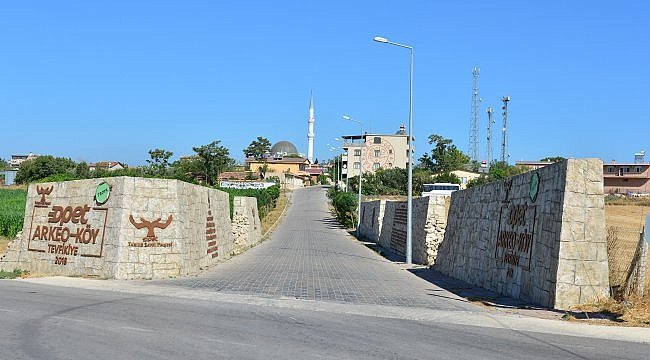BY THE ARCHAEOLOGIST EDITOR GROUP
Busts of the Achaean (Mycenaean Greek) and Trojan heroes of the Trojan War can be found in the Troy Observation Terrace (Truva Seyir Terası), located in the village of Tevfikiye, one kilometer away from the archaeological site of ancient Troy.
The observatory offers an ideal view of the mythical plain of the Skamandros River (Turkish: Karamenderes). The city of Troy itself was located on a hill in this particular plain, where the homeric battles of the Trojan War took place.
The Achaean Greeks set up their camp near the mouth of the river Scamander, where they ran aground their ships. The site of the ancient city today is about 15 kilometers from the coast, but the ancient estuary of Skamandros 3,000 years ago was about 5 kilometers further inland, opening into a bay that has since been silted up.
The building of the observatory resembles the prehistoric architecture of the palaces of Troy, with its characteristic columns and wall ends, as we know exactly from the representations of the Homeric city.
Troy VI was a city with robust fortifications, and architecturally sophisticated palace complex and common houses; obviously the capital of an extensive and prosperous state which controlled the Straits of Hellespont (modern Dardanelles) and the regions of the Thracian Peninsula and Troas (and a few more districts and islands).
An illustration shows Troy more than 3,000 years ago, corresponding with the era described by Homer. The inner city housed the ruling elite. The lower city was discovered only in the 1990s, and it expanded the settlement’s overall footprint tenfold. Findings suggest that Homeric Troy was home to as many as 10,000 people, and there is evidence that Anatolians from elsewhere sought refuge there during attacks by invading Greeks.
Christoph Haußner, München
In general Troy VI fully meets the descriptions of the Homeric epics and other epics of the Trojan Cycle considering the richness and power of Troy. Troy VI survived for six centuries of prosperity and security behind her sturdy walls. The towers of the citadel walls were built around 1300 BC, several decades before her destruction, possibly due to increased danger because of Hittite, Achaean, Thracian, Phrygian and other aggressors.
Illustration showing daily life in the ancient city of Troy, believed to be located in modern-day Turkey. The city of Troy was the site of the famous Trojan War. Credit
Tevfikiye village turned into a Troy-era archaeology park
Tevfikiye village in the northwestern province of Çanakkale has been turned into an archeology village depicting the Troy era.
As part of a protocol signed by the Çanakkale Governor’s Office on Nov. 21, 2017, the village became an archaeology park due to its buildings and structures reminiscent of the Troy era as well as its rich history and mythological values. The goal is to make people visit the village during their tour to the ancient city of Troy and buy organic products and souvenirs from locals.
According to the recent history of the village, Bulgarian immigrants who wanted to save their lives from the 1877-1878 Ottoman - Russian War settled here. In the meantime, it is known that the famous Schliemann also made excavations when they came, and those who came made their living by working with Schliemann, that is, in excavations.
The settlers built their houses with reeds and stones they brought from the excavation site . When the population increased, they wanted to become a village in 1891. In fact, the village mosque was built from the natural stones of the ancient city by a Greek craftsman from İntepe/Erenköy in 1895. The square, created at a spot that overlooks the wide Troy plain and called the “square of Troy,” was recreated as an observation area. The busts of the Troy-era heroes such as Sarpedon, Priamos, Paris, Helen, Homers and others were placed in this square.
A building in the garden of the village’s coffeehouse was renewed with the concept of the Troy house. A miniature waterfall was created in a field between the Troy Square and the mosque. The wedding hall in the village square was transformed into a museum and a culture and arts center.
What You Must Do in Tevfikiye Archaeo-Village
Make sure to take pictures in front of the ancient-looking houses with the symbols and inscriptions about the Trojan heroes and the history of Troy.
See the health center and wedding hall decorated similarly to the Trojan 6 period.
Visit the village's old mosque, made from the stones of the Ancient City of Troy by a Greek master.
Check out the busts of Trojan heroes in the square overlooking the famous Trojan Plain . Enjoy the view between Sarpedon, Priam, Paris, Helen, Hector, Homer, Achilles, Agamemnon, Aias, Patraclos, Odysseus.
Enter the House of Troy. In this house, which is one of the most beautiful tangible cultural items ever built, stand at the door of the house, wander through the rooms, look out of the windows to feel the antiquity.
Troy, with its 4,000 years of history, is one of the most famous archaeological sites in the world. The first excavations at the site were undertaken by the famous archaeologist Heinrich Schliemann in 1870. In scientific terms, its extensive remains are the most significant demonstration of the first contact between the civilizations of Anatolia and the Mediterranean world.
Troia, Dardanelles and islands
Throughout the centuries, Troy has acted as a cultural bridge between the Troas region and the Balkans, Anatolia, the Aegean and Black Sea regions through migration, occupation, trade and the transmission of knowledge. Moreover, the siege of Troy by Achaean warriors from Greece in the 13th or 12th century B.C., immortalized by Homer in the Iliad, has inspired great creative artists throughout the world ever since.

























